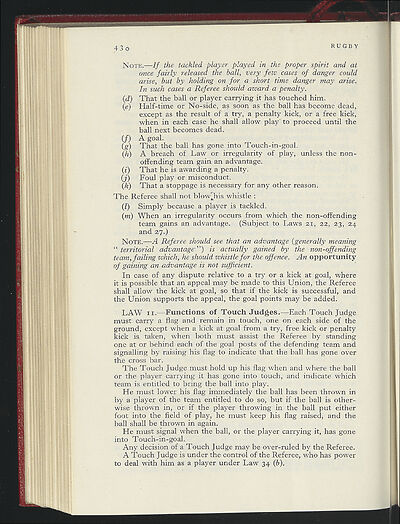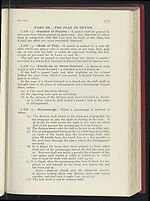1938-39
(458)
Download files
Complete book:
Individual page:
Thumbnail gallery: Grid view | List view

RUGBY
N
OTE.
—If the tackled player played in the proper spirit and at
once fairly released the ball, very few cases
of
danger could
arise, but by holding on for a short time danger may arise.
In such cases a Referee should award a penalty.
(d)
That the ball or player carrying it has touched him.
(e)
Half-time or No-side, as soon as the ball has become dead,
except as the result of a try, a penalty kick, or a free kick,
when in each case he shall allow play to proceed until the
ball next becomes dead.
(f) A goal.
(g)
That the ball has gone into Touch-in-goal.
(h)
A breach of Law or irregularity of play, unless the non-
offending team gain an advantage.
(i) That he is awarding a penalty.
(j) Foul play or misconduct.
(k)
That a stoppage is necessary for any other reason.
The Referee shall not blow
-
.his whistle:
(l) Simply because a player is tackled.
(m) When an irregularity occurs from which the non-offending
team gains an advantage. (Subject to Laws zi,
22,
23, 24
and
27.)
N
OTE.—
A
Referee should see that an advantage (generally meaning
" territorial advantage") is actually gained by the non-offending
team, failing which, he should whistle for the offence. An
opportunity
of gaining an advantage is not sufficient.
In case of any dispute relative to a try or a kick at goal, where
it is possible that an appeal may be made to this Union, the Referee
shall allow the kick at goal, so that if the kick is successful, and
the Union supports the appeal, the goal points may be added.
LAW i i.—
Functions of Touch Judges.
—Each Touch Judge
must carry a flag and remain in touch, one on each side of the
ground, except when a kick at goal from a try, free kick or penalty
kick is taken, when both must assist the Referee by standing
one at or behind each of the goal posts of the defending team and
signalling by raising his flag to indicate that the ball has gone over
the cross bar.
The Touch Judge must hold up his flag when and where the ball
or the player carrying it has gone into touch, and indicate which
team is entitled to bring the ball into play.
He must lower his flag immediately the ball has been thrown in
by a player of the team entitled to do so, but if the ball is other-
wise thrown in, or if the player throwing in the ball put either
foot into the field of play, he must keep his flag raised, and the
ball shall be thrown in again.
He must signal when the ball, or the player carrying it, has gone
into Touch-in-goal.
Any decision of a Touch Judge may be over-ruled by the Referee.
A Touch Judge is under the control of the Referee, who has power
to deal with him as a player under Law 34 (b).
N
OTE.
—If the tackled player played in the proper spirit and at
once fairly released the ball, very few cases
of
danger could
arise, but by holding on for a short time danger may arise.
In such cases a Referee should award a penalty.
(d)
That the ball or player carrying it has touched him.
(e)
Half-time or No-side, as soon as the ball has become dead,
except as the result of a try, a penalty kick, or a free kick,
when in each case he shall allow play to proceed until the
ball next becomes dead.
(f) A goal.
(g)
That the ball has gone into Touch-in-goal.
(h)
A breach of Law or irregularity of play, unless the non-
offending team gain an advantage.
(i) That he is awarding a penalty.
(j) Foul play or misconduct.
(k)
That a stoppage is necessary for any other reason.
The Referee shall not blow
-
.his whistle:
(l) Simply because a player is tackled.
(m) When an irregularity occurs from which the non-offending
team gains an advantage. (Subject to Laws zi,
22,
23, 24
and
27.)
N
OTE.—
A
Referee should see that an advantage (generally meaning
" territorial advantage") is actually gained by the non-offending
team, failing which, he should whistle for the offence. An
opportunity
of gaining an advantage is not sufficient.
In case of any dispute relative to a try or a kick at goal, where
it is possible that an appeal may be made to this Union, the Referee
shall allow the kick at goal, so that if the kick is successful, and
the Union supports the appeal, the goal points may be added.
LAW i i.—
Functions of Touch Judges.
—Each Touch Judge
must carry a flag and remain in touch, one on each side of the
ground, except when a kick at goal from a try, free kick or penalty
kick is taken, when both must assist the Referee by standing
one at or behind each of the goal posts of the defending team and
signalling by raising his flag to indicate that the ball has gone over
the cross bar.
The Touch Judge must hold up his flag when and where the ball
or the player carrying it has gone into touch, and indicate which
team is entitled to bring the ball into play.
He must lower his flag immediately the ball has been thrown in
by a player of the team entitled to do so, but if the ball is other-
wise thrown in, or if the player throwing in the ball put either
foot into the field of play, he must keep his flag raised, and the
ball shall be thrown in again.
He must signal when the ball, or the player carrying it, has gone
into Touch-in-goal.
Any decision of a Touch Judge may be over-ruled by the Referee.
A Touch Judge is under the control of the Referee, who has power
to deal with him as a player under Law 34 (b).
Set display mode to:
![]() Universal Viewer |
Universal Viewer | ![]() Mirador |
Large image | Transcription
Mirador |
Large image | Transcription
| Games and sports in the army > 1938-39 > (458) |
|---|
| Permanent URL | https://digital.nls.uk/248742560 |
|---|
| Description | 'Games and Sports in the Army' was an annual publication produced by the British War Office between the 1930s and 1960s. This included the Second World War. It outlines the rules and regulations for games and sports played by members of the armed forces. It features names and photographs of team members, and examples of contemporary advertising. |
|---|---|
| Shelfmark | GWB.52 |

